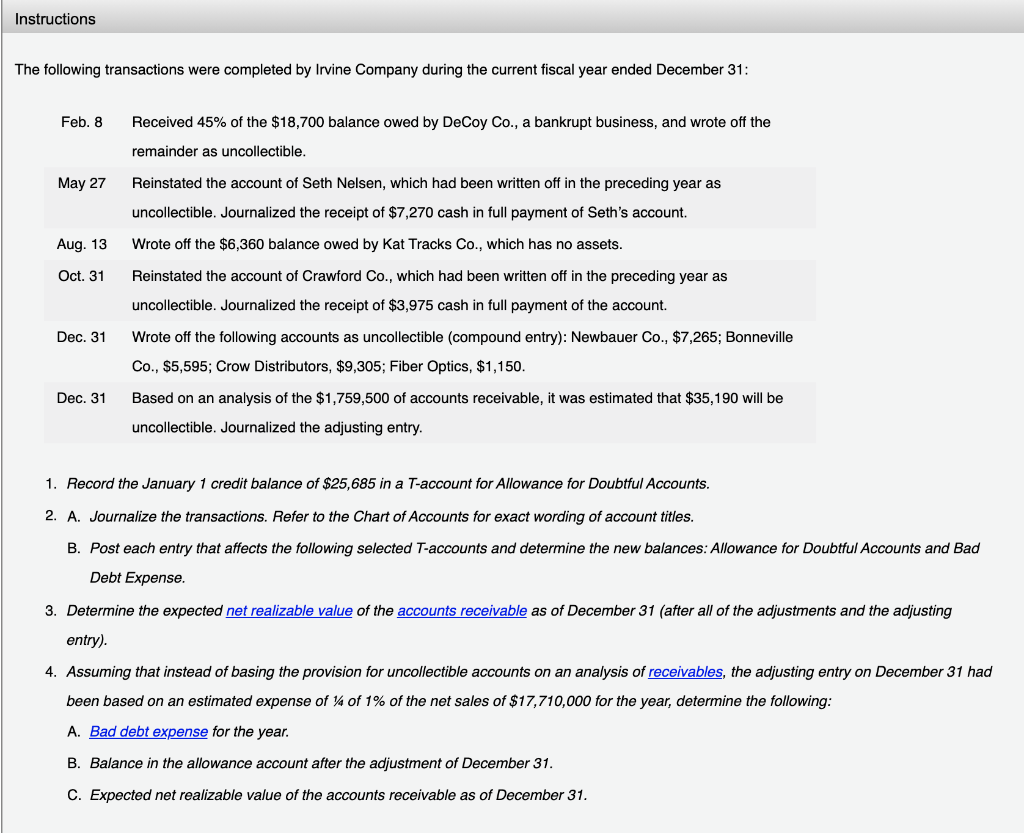Answered step by step
Verified Expert Solution
Question
1 Approved Answer
Just need the final questions Instructions The following transactions were completed by Irvine Company during the current fiscal year ended December 31: Feb. 8 Received




Just need the final questions
Instructions The following transactions were completed by Irvine Company during the current fiscal year ended December 31: Feb. 8 Received 45% of the $18,700 balance owed by DeCoy Co., a bankrupt business, and wrote off the remainder as uncollectible. May 27 Reinstated the account of Seth Nelsen, which had been written off in the preceding year as uncollectible. Journalized the receipt of $7,270 cash in full payment of Seth's account. Aug. 13 Wrote off the $6,360 balance owed by Kat Tracks Co., which has no assets. Oct. 31 Reinstated the account of Crawford Co., which had been written off in the preceding year as uncollectible. Journalized the receipt of $3,975 cash in full payment of the account. Wrote off the following accounts as uncollectible (compound entry): Newbauer Co., $7,265; Bonneville Co., $5,595; Crow Distributors, $9,305; Fiber Optics, $1,150. Dec. 31 Dec. 31 Based on an analysis of the $1,759,500 of accounts receivable, it was estimated that $35,190 will be uncollectible. Journalized the adjusting entry. 1. Record the January 1 credit balance of $25,685 in a T-account for Allowance for Doubtful Accounts. 2. A. Journalize the transactions. Refer to the Chart of Accounts for exact wording of account titles. B. Post each entry that affects the following selected T-accounts and determine the new balances: Allowance for Doubtful Accounts and Bad Debt Expense. 3. Determine the expected net realizable value of the accounts receivable as of December 31 (after all of the adjustments and the adjusting entry) 4. Assuming that instead of basing the provision for uncollectible accounts on an analysis of receivables, the adjusting entry on December 31 had been based on an estimated expense of 14 of 1% of the net sales of $17,710,000 for the year, determine the following: A. Bad debt expense for the year. B. Balance in the allowance account after the adjustment of December 31. C. Expected net realizable value of the accounts receivable as of December 31. T-Accounts 1. Record the January 1 credit balance of $25,685 in a T-account for Allowance for Doubtful Accounts. 2. B. Post each entry that affects the following selected T-accounts and determine the new balances: Allowance for Doubtful Accounts and Bad Debt Expense. Allowance for Doubtful Accounts Feb. 8 10,285 Jan. 1 Balance 25,685 Aug. 13 6,360 May 27 7,270 Dec. 31 23,315 Oct. 31 3,975 Dec. 31 Adjusting Entry 36,930 Dec. 31 Unadjusted Balance 3,029 Dec. 31 Adj. Balance 35,190 Bad Debt Expense Dec. 31 Adjusting Entry 36,930 2. A. Journalize the transactions. Refer to the Chart of Accounts for exact wording of account titles. PAGE 10 JOURNAL ACCOUNTING EQUATION DESCRIPTION POST. REF. DEBIT CREDIT ASSETS LIABILITIES EQUITY DATE Feb. 8 1 Cash 8,415.00 1 2 Allowance for Doubtful Accounts 10,285.00 1 3 Accounts Receivable-DeCoy Co. 18,700.00 1 4 May 27 Accounts Receivable-Seth Nelsen 7,270.00 f 5 Allowance for Doubtful Accounts 7,270.00 1 6 May 27 Cash 7,270.00 1 7 Accounts Receivable-Seth Nelsen 7,270.00 1 Aug. 13 Allowance for Doubtful Accounts 6,360.00 t 9 Accounts Receivable-Kat Tracks Co. 6,360.00 + 10 Oct. 31 Accounts Receivable-Crawford Co. 3,975.00 1 11 Allowance for Doubtful Accounts 3,975.00 1 12 Oct. 31 Cash 3,975.00 1 13 Accounts Receivable-Crawford Co. 3,975.00 1 14 Dec. 31 Allowance for Doubtful Accounts 23,315.00 1 15 Accounts Receivable-Newbauer Co. 7,265.00 1 16 Accounts Receivable-Bonneville Co. 5,595.00 17 Accounts Receivable-Crow Distributors 9,305.00 1 18 Accounts Receivable-Fiber Optics 1,150.00 + 19 Dec. 31 Bad Debt Expense 35,190.00 1 20 Allowance for Doubtful Accounts 35,190.00 + Final Questions 3. Determine the expected net realizable value of the accounts receivable as of December 31 (after all of the adjustments and the adjusting entry). $ 4. Assuming that instead of basing the provision for uncollectible accounts on an analysis of receivables, the adjusting entry on December 31 had been based on an estimated expense of 14 of 1% of the net sales of $17,710,000 for the year, determine the following: A. Bad debt expense for the year. $ B. Balance in the allowance account after the adjustment of December 31. $ C. Expected net realizable value of the accounts receivable as of December 31. $Step by Step Solution
There are 3 Steps involved in it
Step: 1

Get Instant Access to Expert-Tailored Solutions
See step-by-step solutions with expert insights and AI powered tools for academic success
Step: 2

Step: 3

Ace Your Homework with AI
Get the answers you need in no time with our AI-driven, step-by-step assistance
Get Started


